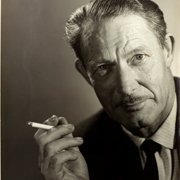
Peter Hutt
For over 30 years — from the late 1930s to the early 1970s — the voice of Peter Hutt was familiar to New Zealand radio listeners and filmgoers. Occasionally his name appeared in the credits as director, writer or editor, but usually the voice went uncredited.
Peter Philip Hutt was born in June 1909 in the English village of Hethersett. He arrived in New Zealand in 1921. No job seemed to suit his temperament, though he tried many, from bank clerk to rubber planter. He even spent a year with a British infantry regiment in Singapore before returning to New Zealand. In 1936 he joined the Commercial Broadcasting Service after someone told him he had "such a hell of a nice voice". It was said that he sounded similar to Welsh-born actor Ray Milland.
Hutt came to public attention as a radio announcer on Auckland station 1ZB. Before he transferred to Wellington's 2ZB, his clear speaking voice had secured him a role in Rudall Hayward’s ambitious feature Rewi’s Last Stand (1940). During the war he served in the Middle East with the Second NZ Expeditionary Force, as a Lieutenant in the 21st Battalion. After being wounded at El Alamein he returned downunder, and took up his old job behind the microphone at 1ZB.
By 1946 Hutt was back working at 2ZB in Wellington and, like a number of his fellow announcers, was asked to record commentaries for the National Film Unit. On his visits to the NFU's studios in Miramar he took a keen interest not only in the filmmaking process, but also in the producer’s secretary, Kay Homersham, who he married in May 1947. Later that year he took on further work at the NFU, writing as well as voicing commentaries for items in the Weekly Review series.
With his appointment as a production assistant made permanent in August 1948, he immediately proved to be a handy man to have on site when a commentator was needed quickly for Weekly Review special news item Crashed Plane Sighted (he also narrated this film on the 1947 Ballantyne's store fire). From time to time such calls on his voice talent would allow tight deadlines to be met, or short films to be brought in under budget.
As a production assistant he also developed skills in editing and directing. His first on-screen credit was as editor for Circus Roundabout, directed by Margaret Thomson and released as Weekly Review No. 398 in April 1949.
Promoted to become a Unit Director in 1950, he was one of the team that contributed to both the editing of the feature-length 1950 British Empire Games, and the writing of its commentary.
When the NFU's monthly magazine series Pictorial Parade began in 1952, Hutt played a significant role in guiding its early years and establishing the tenor of the series, eventually contributing to about 60 items or full-reels. His early directing credits include 1953's Hillary Returns, which follows Edmund Hillary's homecoming after climbing Everest.
As the NFU laboratory was equipped to process only black and white film, colour film was not used frequently since it had to be sent overseas for processing. The first colour film Hutt directed was Portrait of Southland, made to mark the centenary of Southland Province in 1956. It was given a Vice-Regal World Premiere in Invercargill.
Perhaps Hutt's most important film, and certainly the one that best illustrates his versatility, was Partners for Peace (1959). Not only did he direct, write, edit and narrate, he was also responsible for some of the camerawork, having travelled through South East Asia for five and a half months documenting the work of defence organisation SEATO.
Other big-screen colour films Hutt directed included Royal Occasion (1962), A Northland Summer (1962), Birth of a Rainbow (1967), Bred to Win (1968), Rotorua Lookabout (1969) and About Sheepdogs (1972). In 1962 he was promoted to Senior Unit Director, a position he held for the rest of his time at the NFU.
In one of the last films he contributed to, television documentary Thursday’s Children (1972), Hutt provided the linking narrative voice-over. In the style of the time, those interviewed on the documentary were identified by captions, but the voice of the unseen narrator, although familiar, went uncredited.
Peter Hutt died of a heart attack at his Wellington home on 24 March 1973. He was 63.
Profile written and researched by Clive Sowry; updated on 8 February 2021
Sources include
Photograph of Peter Hutt: Auckland Libraries Heritage Collections, Image ID 34-232. Photographer Clifton Firth
'Mr P Hutt' (Obituary) – The Evening Post, 27 March 1973, page 6
'Hutt, Peter Philip' (Death Notice) – The Evening Post, 26 March 1973, page 33
Unknown writer, ‘Explaining Its Significance. Impressive First is Film on SEATO’ – The Evening Post, 16 February 1959, page 13
Unknown writer, ‘Film Tells How All Races Are Alike’ – The Dominion, 17 February 1959, page 5
Unknown writer, ‘Wedding of Interest in Broadcasting and Film Unit Circles’ – The Dominion, 5 May 1947, page 5
Unknown writer, 'Man Behind the Voice, No. 27, Peter Hutt' - Newsview, February 1950, page 93 (Volume 6, no 58)
Unknown writer, ‘Back Again’ – The Listener, 2 April 1943, page 2 (Volume 8, no 197)
Unknown writer, ‘The ZB Radiogram. New Voices’ – The Listener, 22 September 1939, page 48 (Volume 1, no 13)